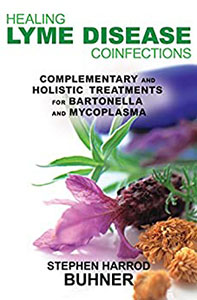Dear Stephen,
My 21 year-old male relative has neuro lyme, bartonella and babesia. His past symptoms have been depression, anxiety and agitation, ADHD, explosive anger; more recently paranoia and brain fog and even more recently social withdrawal after a new July tickbite which caused a relapse apparently due to babesia. He tried the Buhner core protocol June of 2011 which caused extreme mood lability during the hour after each dose. His family had to leave the house for an hour each time as when the herbs killed the bacteria his impulse control went way down until the anti-inflammatory properties of the herbs kicked in and seemed to neutralize the inflammatory cascade. His family couldn’t sustain leaving the house for an hour three times a day for treatment so it was stopped. The herx’s from 4 different antibiotics he tried after that lowered impulse control so much they were discontinued, even when the antibiotic dosages were decreased. My relative’s current treatment is for babesia with the Byron White formula A-Bab. He has had a positive “energetic shift” which seems to indicate this is going well but extremely slowly so as to try and avoid herx reactions.
Current herx reactions happen anyway; every week to ten days. They are unpredictable and intense and mostly consist of extreme short-term rage which he struggles to control, at times very poorly. His current protocol is: – A-Bab 2/3’s drop daily for babesia (maintenance dose 30 drops a day). He can tolerate this small dosage and it is being raised slowly. – Zinc picolinate/copper as per Buhner protocol to bind neurotoxins. These work very well for him – big difference in paranoia level. – Travacor for depression and anxiety (total daily zinc dose 60mg/last dose close to melatonin). This works somewhat. – 4 Lyprinol for inflammation (highly anti inflammatory marine oil) Unsure if this is helping. – 1800 EPA/1200 DHA Omegas daily. He does really well with Omegas-seem to help. – 1000 mg Niacin for high dopamine/social withdrawal. Okay but dose not high enough to solve the problem? Niacin somewhat antibiotic, when we raise to 2000mg it causes a herx. – 150mg Japanese knotweed 1x day. He can take this dose without an immediate herx. – 113mg Betasitosterol 3x day to bind toxins. Unsure if it helps. – 1275 mg Sarsaparilla 3x day Seems to tolerate this herb; unsure if this dosage is correct for him. – 60 drops Red Root tincture 3x day. This seems to help things flow; it reduced a lymph node in the neck that had been swollen for 10 yrs.
Even with a protocol which seems to have a number of things working well, there is still something central missing. Please give us your opinion if you can as to what changes you would make, as this young man’s family are at the end of their rope with the rages.
I have begun researching high histamine levels/low methylation issues and the relationship to systemic high ammonia levels. The type of sudden onset extreme rage seems consistent with a more minor angry outburst that I witnessed a year ago when my relative ate chicken and drank some lemonade. Within 15 minutes he had an outburst. I have read that the extreme alkalinity of lemonade can increase already high lyme ammonia levels and combined with the l arginine in the chicken can quickly create nitric oxide, causing brain swelling and psychiatric symptoms. My relative’s rages have that sudden intense type of quality to them. But even if this is correct – what to do? Thanks so much for your time. Right now this rage symptom seems to be the main obstacle in his lyme treatment. If we can solve it’ll make a huge difference for this young man and his family.
Stephen’s response:
in our experience explosive rage is usually bartonella generated (not always but usually). We highly recommend treating for bartonella. Reversing this can take time, in very extreme cases as much as a year to eighteen months. I would highly suggest he work with someone experienced in this area as the protocol usually needs extensive tweaking for each individual. My partner Julie McIntyre is highly experienced with it. Nevertheless, please see the bartonella protocol that is mentioned in depth on this site (it is more extensive than the book):
https://buhnerhealinglyme.com/herbs/lyme-with-bartonella/.
Stephen












BILLY’S PROTOCOL
for Curing Lyme Disease
Bill Tieckelmann Berkeley CA 6.19.12
First, I learned virtually everything I know about Spirochetes and their behavior from Steven Buhner’s book Healing Lyme. The primary difference between this and other protocols is that they all attempt to kill the spirochetes. I tried everything but decided lethal protocols — strategies that attempt to kill the spirochetes — are either impossible, so difficult as to make them impracticable, or cause the victim significant harm or discomfort. That’s possibly because the detritus of dead spirochetes left in ones body are terribly poisonous.
If one does succeed in killing a significant number — at least in the short run — it’s can be much worse than the day to day symptoms — by an order of magnitude! I suffered horribly, when I successfully killed lots of them. It’s likely a Herxheimer reaction. Steven Buhner warns about it over and over. He’s right. It is wretched! It might be tolerable, if it were a cure. It’s not close.
The predicament is that spirochetes, if they perceive a threat, can encyst in less than a minute. They are so tuned in that, supposedly, if two ticks bite an animal at the same time, if one tick is not infected, the spirochetes target the other tick before attacking the animal. True or apocryphal, it’s safe to say, that may be difficult to ambush. Andrographis is an amazing herb, it appears to virtually slaughter them, encysted or not: a microbial WMD. I have rarely been so miserable. I’d bet it Andrographis wipes them out in droves. Every inch of skin had a rash and itched insanely… for six weeks! Steroids had almost no effect. That was the last time I tried to kill them. After that it was Martin Luther King Jr. meets the Pied Piper.
I had to develop a non-lethal strategy. The idea occurred to motivate, not disable them. I thought of it as microbiological Tai Chi. Perhaps I could take their own energy and redirect it.
Spirochetes must be one of the most successful, adaptable, totally amazing life forms ever. The more I learned about spirochetes, the more I became in awe of them. That’s good, because I had to learn to almost think like one. If I were a spirochete, what would I do, what could I do? It became for me a sort of brain duel. One of the oldest intelligences on earth against the latest model. I was having fun imagining some impending titanic comic book battle. You have to see a spirochete really close up. It looks like a spiraled, living, armored, alien, battle cruiser that can suddenly recoil into something reminiscent of Star Wars’ Empire’s Death Star. It seems to have sophisticated cloaking strategies.
The spirochetes admittedly should have been down on their luck, after I tried relentlessly to kill them for so long. But it never worked. They were thriving.
So, here’s what I did.
Spirochetes are so amazingly sophisticated that when they detect the presence of an antibiotic or an immune system component that’s on their case, they shed part of their exoskeleton. It’s called “bleb.” It works exactly like a modern fighter-jet, which sheds aluminum chafe to draw away guided missiles that have locked on to it. Whatever is attacking the spirochete is drawn toward the bleb and the spirochete escapes.
If the environment becomes overly hostile they completely encyst in less than a minute for at least 8 to10 hours, they are then virtually invulnerable, symptoms abate, the spirochetes are dormant. They can stay like that for up to 10 months. If they can kept encysted for that whole time with no food and no reproduction they will become exhausted and die, literally extinct. That’s probably what treating Lyme with antibiotics does eventually. That’s why the treatment lasts a year or more, just to be sure. I doesn’t always work (some say it doesn’t actually work at all.) That much antibiotics risks virtually wiping out the human biome as well — far too effectively. As far as I was concerned, it was an extremely bad strategy, totally inadvisable. But until now, it’s all we’ve really had.
It may simply be that it takes a long time for spirochetes to burrow in deep enough to avoid antibiotics, which could explain why new cases can sometimes be cured with antibiotics. After the disease progresses, antibiotics don’t work, by that time they’ve learned to hide too well, or simply found safe places to live. After a while they can be found in places far from the blood stream, where antibiotics and other meds just can’t reach them. In time they re-emerge.
By the time they do reemerge they have analyzed the environment outside their encysted defense posture. And here’s the most amazing thing: They can alter their DNA to suit the conditions outside their enclosure. It is believed that they have at least 24 different strands of DNA to mix and match. When they have it together, all at once, they emerge and launch a coordinated attack. They are so amazing!
What can you do against that? What indeed, is what I had to figure out.
I had to face the fact that they simply cannot be effectively killed. They can adapt like nothing else. They must be out-smarted. I think that I tricked them into committing suicide!
Heres how it works: Medication and your immune system are constantly after them, wearing them down, Forcing them to keep making new exoskeletal tissue (bleb) all the time exhausts them physically. They hate oxygen, so raising the oxygen content of your blood is critical. Aerobic exercise is extremely important. There is a vitamin/mineral supplement — called something like Oxylent. It purports increase oxygen in the blood. I took it every other day. I used principally Eluterococcus S.(siberian ginseng) to boost my immune systems attack. I also used other herbs: Cat’s claw, Red Root.. All the herbs employed are described in excellent detail by Steven Buhner. My criteria for use were: (1) enhances immune response (2) aids in waste removal from blood or lymph, or (3) detoxifies.
Spirochetes can freeze and thaw with no problems, but they hate heat. The trick is, when you’ve got ’em really uncomfortable, take hot baths. The hottest bath you can stand. I worked up to about 115° F. (a regular weather thermometer is fine for measuring) It takes a while to get used to it. The thermometer helps keep the water as hot as is comfortable without getting burned, and aids in increasing the temperature methodically as one slowly acclimates to higher temperatures.
The objective is to raise the victim’s core temperature to as high as they can stand it — in the beginning it’s uncomfortable. MOST IMPORTANT OF ALL: While in the bath, keep the parts of the body that can’t be submerged wet, so evaporation will cool the areas exposed to air.
The spirochetes have a chemical on their nose, which, if it touches your soft tissue, opens a hole right up so they can move, what I call, cross-country — that is, without accessing the blood stream at all.
If they want out of your body, they just put their nose up against the inside of your skin and they’re out.
Now is the time. Unrelenting attacks from the immune system; their defenses are wearing thin down, they hate the flipping oxygen. Heat is the last straw. They head straight for the cool spots in the skin, and they blow through the skin like the General Lee through a closed barn door.
They are far too small to see well, even with a microscope, but you sure can feel them. There is no mistake about it. The skin prickles like crazy, but only where it’s cool.
When I realized what was going on and that the strategy was working — even though it was exactly what I was trying to do — it blew my mind completely. I never anticipated the prickly feeling, a true Eureka! moment. Without that feeling I could not have figured it out. I kept it up until there was no more prickly feeling at all on my skin, when I took a really hot bath. Now, nothing like that ever happens. If I wanted to use soap or Epsom Salts, I took a different bath. The water for treatments was always clear and clean so I wouldn’t risk scaring them off. I believed it had to be an appealing environment to best lure them out.
I couldn’t be sure it worked, until almost a month later, when I had test results confirm it did. Sure enough, about 3-4 months after I started this routine, no trace of Lyme whatsoever. I’m reasonably certain, had I known exactly what was going to happen right from the start, that the whole thing could have been accomplished in well under a month.
I was afraid the spirochetes might try to hang on to my skin and then work their way back in, so I gently scrubbed my skin with a stiff fingernail brush (sharp, flat-cut bristles, not with ends polished round) to make sure they were all dislodged. And it worked!
Important Note: In the beginning some seem to escape into the lungs and you just have to get out of the tub and not get back in (1-5 min.) until it’s easy to breath again. Try to cough up whatever you can before that.
So, that’s my story and I’m sticking with it. I hope this protocol works for everybody who tries it.
Wow. I was totally enthralled by your narrative–it reads like the best science fiction or suspense. I’ve also noticed that when I start to explain the brilliance of the spirochetes to people that it starts to sound like a 50-‘s horror movie–I’m sure that a huge percentage of my captive audience (ancient mariner, anyone?) either don’t believe me or are unable/unwilling to grasp what I’m saying……
Your approach is also brilliant. Scary but not as scary as living the rest of my life with Lyme. I won’t go on about myself, except to say that I’m ready to try your approach! Yep. I’m going to have to time it right, which may mean waiting until next week but I totally understand how you arrived at this drastic conclusion and I LOVE that you use the concept of “tricking them into committing suicide’ — because that’s what they’re doing to ME! More like seducing me into committing suicide, actually.
Okay. I’ll get back to you. Many, many thanks for this. There may be more than one way to “kill a spirochete” — but getting themselves to kill themselves? Priceless.
All the best~~
susan
G’day Susan….(& Bill!).
How are you guys!? Howd you go with Bill’s treatment Susan…did it work?!? It does sound worth a shot!
:-)
I am so sorry to hear about your relative’s troubles with rage. Has his family looked into his copper levels? Someties high copper can cause rage. Sometimes it is in excess and deficient at the same time because it is biounavailable.
MCAS is mast cella ctivation syndrome and linked with Bartonella. Indeed MCAS and Bart have an awful lot of similar symptoms making me wonder of they are usually seen together. Bart lays down new blood vessels and that would increase your mast cells and then you get excess histamine and ammonia and quinolinic acid and yes like an allergic reaction – come the rages. We finally had to put my 21 year old son on clozapine as he broke two of his father’s ribs one night. Very scary stuff. But then I looked into why clozapine worked and saw it is calming histamine by binding )in a reverse way) with Histamine 1,2,3 receptors. And also it calms glutamate and balances NMDA receptors which is the one with glycine. Again rage when these receptors do not work — just read autoimmune encephalitis “Brain in Fire” to see what brain swelling looks like on those receptors…and GABA as well. So there are two genetic linked conditions — one is porphyria (which is an interruption in heme synthesis in the body and this sloughs off a neurotoxin that effects the brain and body) and there there is mast cell activation syndrome (MCAS) which is related to mastocytosis – the genetic disease.One might have both really — if you react very badly to many many medications. Anyway – am hoping to find ways to calm the system and stop the release f inflammatory markers as well as look at ways to get them to exit whole… we need to avoid more rages…
Bill thats an amazing theory you share here. On my case my lyme its creating havoc on my body. About the exerxise i feel like im intolerant of my chest pain..I used to be a very active person ..i used to do steps and cardiokickboxing but now i feel afraid of dping it because of ny heart symptons ..what would u recommend for it..i want to become active again!!
Bill, are you still well after your assault on the Lyme buggers?
Angela, have you found any answers to help with your son’s rage? We are in the same boat, except that antipsychotics make him worse.
I also tried to think like a spirochete! They love manganese? Great, I would starve myself of manganese for several months. Then lure them out of hiding with some spinach and a few hours later attack with antibiotic. I realize this is a forum that promotes herbal remedies and I had every intention of using them in my next line of defense. I haven’t had to, but if I do it will also be with what I call my “Trojan horse” method.
Yes. Years have passed and I am in full recovery. I was in constant pain, could barely walk, the fatigue alone was crippling, almost paralytic. Now, whenever I have a tick bite, and I have them frequently, I engage the protocol. Everyone I know, without exception, who has tried this has experienced complete relief. Lyme disease, once a scourge among my friends is rarely a problem. One friend with a very advanced case was on an antibiotic pic for years without results. He is recovering. Lyme does a lot of damage that takes time and a healthy lifestyle to recover from. Because recovery is slow, I seem to feel younger every year This protocol is being promoted by doctors I know with significant success. There is research ongoing to refine the technique. I m led to believe this protocol is listed in some AMA manual of practice as “naturopathy, hydrotherapy”
Hi! I’m not sure exactly what co-infection I have with my Lyme but I’m really looking to get help to at least put this in remission if not possibly be completely cured. How can I tell what co-infection I have? I’ve been told by another “Lymie” that it sounds like I have Bartonella because of my neuropathy problems. I’ve had the flu like feelings, the aches, extreme fatigue which all lasted about 10 days during some bouts I’ve had. I’ve also had some diarrhea, and I believe Candida, but I’ve never been seen for all these symptoms. I’ve only been tested and treated for the Lyme and given antibiotics, but I’m thinking it was possibly too late to be able to cure me. I’m thinking it might’ve at least stopped it in his tracks and kept it from getting even worse. I live in Oklahoma and Lyme disease was once almost unheard of, not to mention there’s hardly any medical professionals who know much about it, and I don’t expect them to. I understand if they don’t, but it would be nice if there were at least a few LLMD’S, and if insurance would help cover my potential treatment costs. I’m on a budget but I’m willing to do what I can afford to help myself. And if you can suggest any supplements y’all sell, that might help me?
Thanks so much!
Heather
Bill, a truly amazing story. Having chronic lyme, I’ve tried everything-except this. Infrared saunas did help but the results weren’t nearly as dramatic as yours. I still have bad cycles. A question: how long did you stay in the bath for each session? Thanks in advance.
Hi Bill, does this work for Bartonella? please let me know as im suffering quite terribly and really hope to use your method. Do you have to wet your whole head + hair, and should you shower after the bath to make sure they’re all out? Thanks